These documents, which cover the years 1940-1941, consist primarily of letters, telegrams, and postcards from Mina Miller Edison to her son Theodore and daughter-in-law Ann. Many of the communications are addressed to Theodore and Ann jointly, but some are addressed to Theodore by himself or Ann by herself. Many of Mina's letters were written from Seminole Lodge, the family's winter home in Fort Myers, Florida, and from Chautauqua, New York, where Mina spent considerable time during the summer. A few items were written from Glenmont, the Edison home in Llewellyn Park; Detroit, Michigan; and various locations in California, which Mina visited during the summer of 1940. In addition to the letters, there is a newspaper clipping from April 26, 1940, containing a photograph of Mina presenting an ebony tree to Rollins College in Winter Park, Florida. The clipping refers to her as "Mrs. Thomas A. Edison," indicating that Mina resumed the use of the Edison name just a few months after the death of her second husband, Edward E. Hughes.
The first item is a telegram sent from Detroit on February 11, 1940 (Edison's ninety-third birthday), which comments favorably upon the movie Young Tom Edison, which had premiered the night before in Port Huron, Michigan. The next four letters were written from Seminole Lodge. Among the visitors mentioned are Ann's mother, Anna Landstrom Osterhout; Frederick A. Traut, who had commanded the naval base at Key West while Edison was working there in 1919; longtime Edison company official Harry F. Miller; conservationist and Pulitzer prize-winning cartoonist Jay Norwood (Ding) Darling; and Mina's younger brother, John V. Miller. The letters from Fort Myers and Chautauqua reveal Mina's concern about the rapidly declining health of her brother, who would die at Chautauqua on August 16. One letter expresses Mina's disappointment about the decision of her oldest son Charles to resign his position as U.S. Secretary of the Navy and run for governor of New Jersey.
Three letters from June 1940 were written during Mina's trip to California, where she visited Yosemite Park with her brother Lewis Alexander Miller. The first letter was written aboard the San Francisco Overland Limited just outside Reno, Nevada. Mina comments disapprovingly that an increasing number of women are coming to Reno for a divorce "not on account of abuse but just the idea that they love another man." The other letters, written from San Francisco and Pasadena, reveal Mina's involvement with Moral Re-Armament (also known as the Oxford Group), a movement founded by evangelist Frank Buchman. She characterizes Buchman, whom she apparently met in California, as a "remarkable man" and writes that "if we had one of his kind in every city there would be no war. . . . Every one sees the only way of peace is through this method or belief of Mr. Buchman." The involvement of Fort Myers real estate developer and family friend Jimmie Newton and Edison scholarship winner Wilbur B. Huston in Moral Re-Armament is also indicated in the letters.
The eight items written from Chautauqua contain numerous comments about the final illness, death, and funeral of John V. Miller. Other topics mentioned in the correspondence include the celebration of Mina's seventy-fifth birthday, a fire in the cottage of Chautauqua President Arthur E. Bestor, and a Moral Re-Armament speech given at Chautauqua by Episcopal Bishop George Ashton Oldham. Also included is a comment about Marcia Miller, Mina's eighty-nine-year-old aunt, who accompanied her back to Chautauqua after attending John's funeral in Akron. According to Mina, she was as "active and alert as one 60."
The eight letters written from Fort Myers in 1941 contain numerous references to Mina's plans to build an Edison Memorial Library across the street from Seminole Lodge and her frustration at the delay in getting the drawings from the architect, William Eagleton Frenaye, Jr. In a lett
 [X456HDV], Telegram from Mina Miller (Mrs Thomas A.) Edison to Theodore Miller Edison, February 11th, 1940 1940-02-11
[X456HDV], Telegram from Mina Miller (Mrs Thomas A.) Edison to Theodore Miller Edison, February 11th, 1940 1940-02-11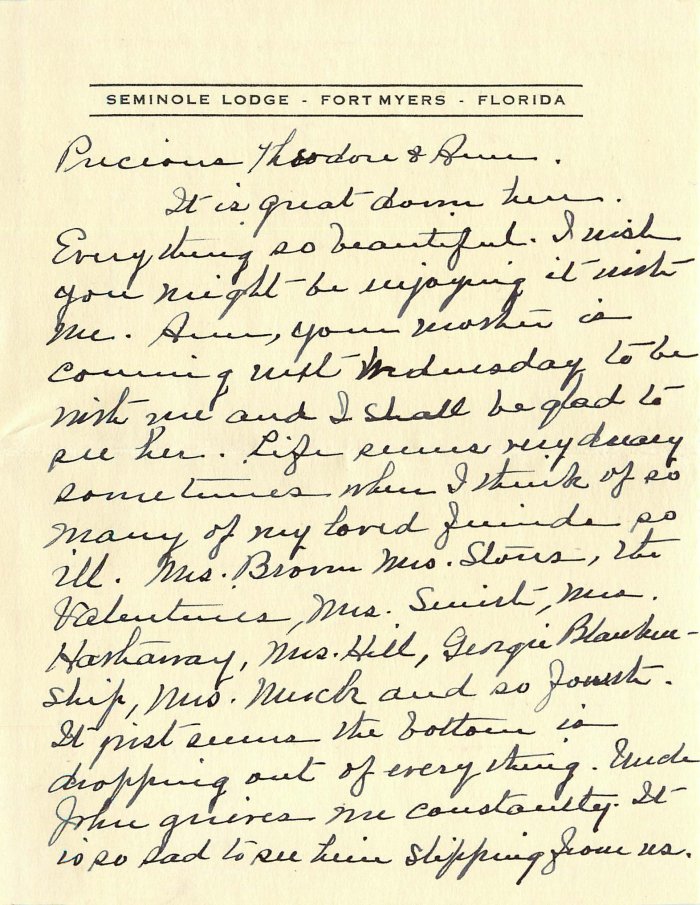 [X456HDW], Letter from Mina Miller (Mrs Thomas A.) Edison to Theodore Miller Edison, Ann Osterhout (Mrs Theodore M.) Edison, March 30th, 1940 1940-03-30
[X456HDW], Letter from Mina Miller (Mrs Thomas A.) Edison to Theodore Miller Edison, Ann Osterhout (Mrs Theodore M.) Edison, March 30th, 1940 1940-03-30 [X456HDX], Letter from Mina Miller (Mrs Thomas A.) Edison to Theodore Miller Edison, Ann Osterhout (Mrs Theodore M.) Edison, April 3rd, 1940 1940-04-03
[X456HDX], Letter from Mina Miller (Mrs Thomas A.) Edison to Theodore Miller Edison, Ann Osterhout (Mrs Theodore M.) Edison, April 3rd, 1940 1940-04-03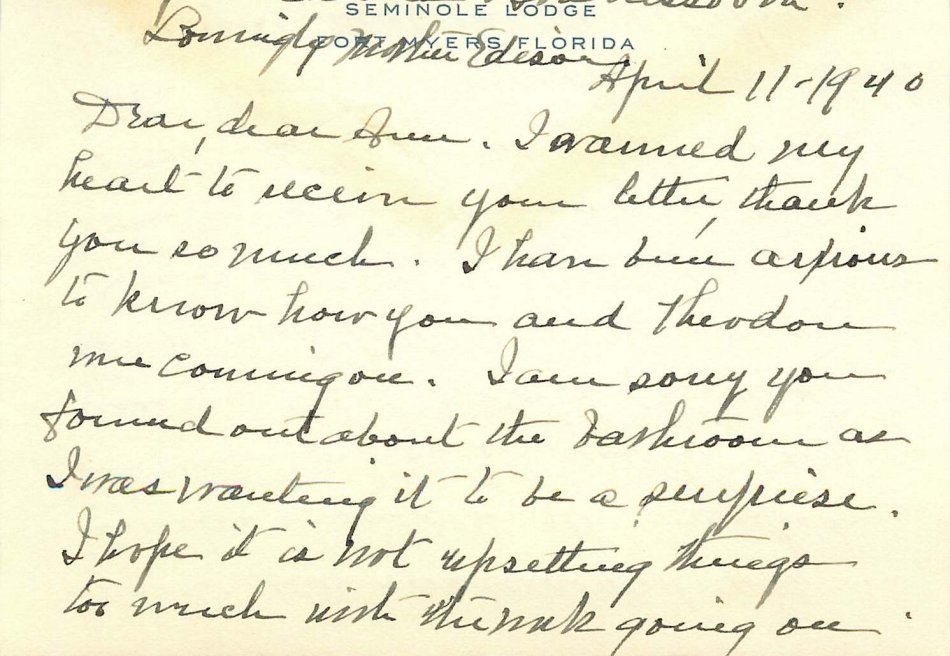 [X456HDY], Letter from Mina Miller (Mrs Thomas A.) Edison to Ann Osterhout (Mrs Theodore M.) Edison, April 11th, 1940 1940-04-11
[X456HDY], Letter from Mina Miller (Mrs Thomas A.) Edison to Ann Osterhout (Mrs Theodore M.) Edison, April 11th, 1940 1940-04-11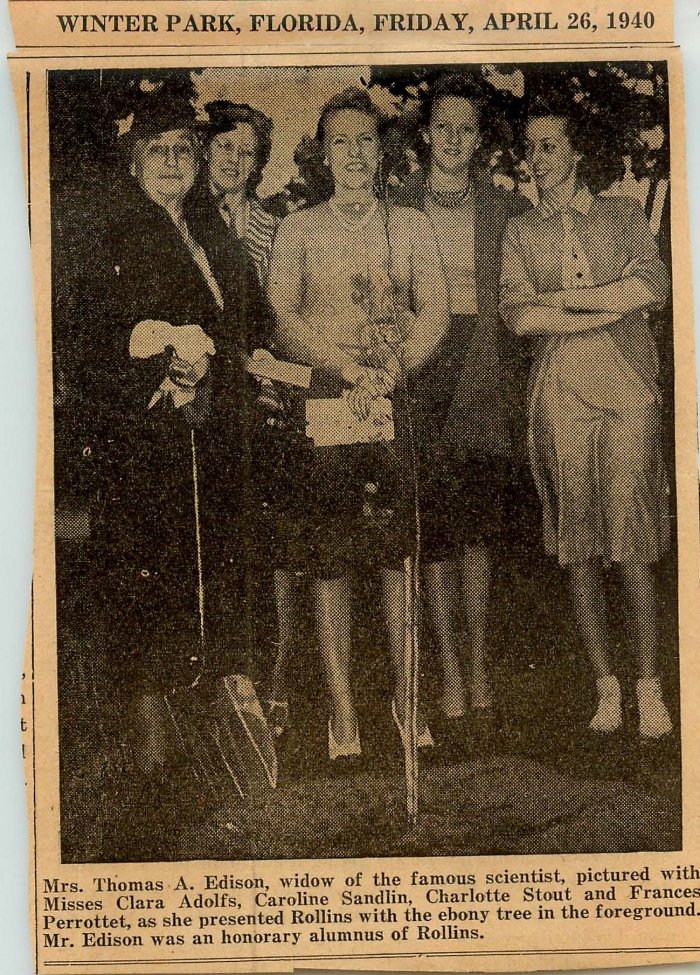 [X456HEA], Letter from Mina Miller (Mrs Thomas A.) Edison to Theodore Miller Edison, Ann Osterhout (Mrs Theodore M.) Edison, April 28th, 1940 1940-04-28
[X456HEA], Letter from Mina Miller (Mrs Thomas A.) Edison to Theodore Miller Edison, Ann Osterhout (Mrs Theodore M.) Edison, April 28th, 1940 1940-04-28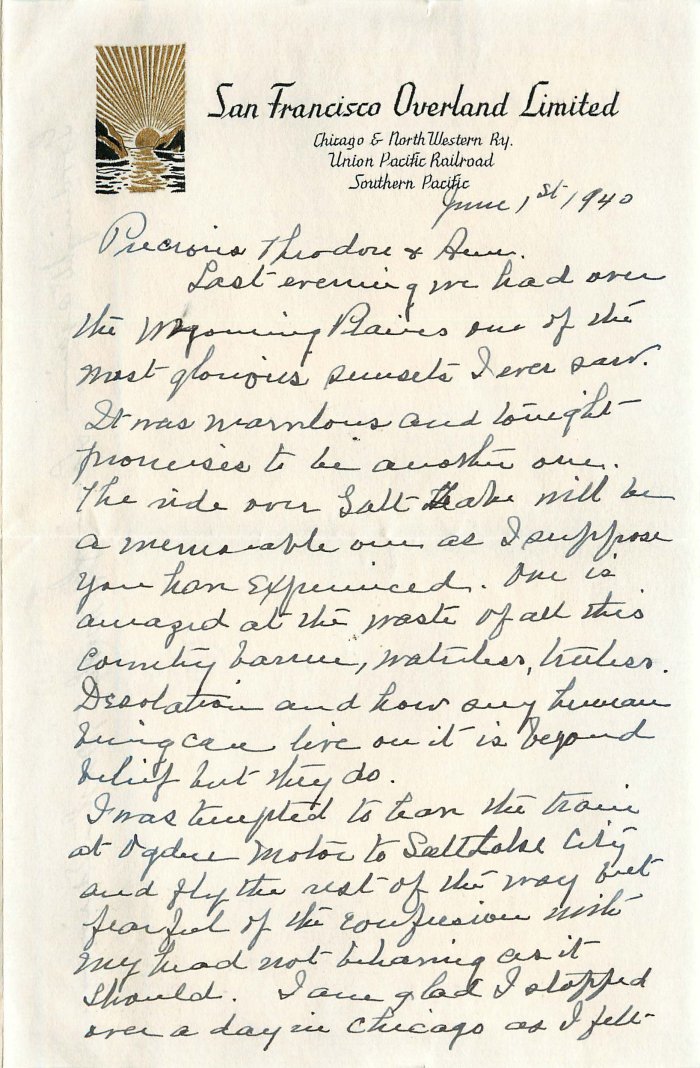 [X456HEB], Letter from Mina Miller (Mrs Thomas A.) Edison to Ann Osterhout (Mrs Theodore M.) Edison, Theodore Miller Edison, June 1st, 1940 1940-06-01
[X456HEB], Letter from Mina Miller (Mrs Thomas A.) Edison to Ann Osterhout (Mrs Theodore M.) Edison, Theodore Miller Edison, June 1st, 1940 1940-06-01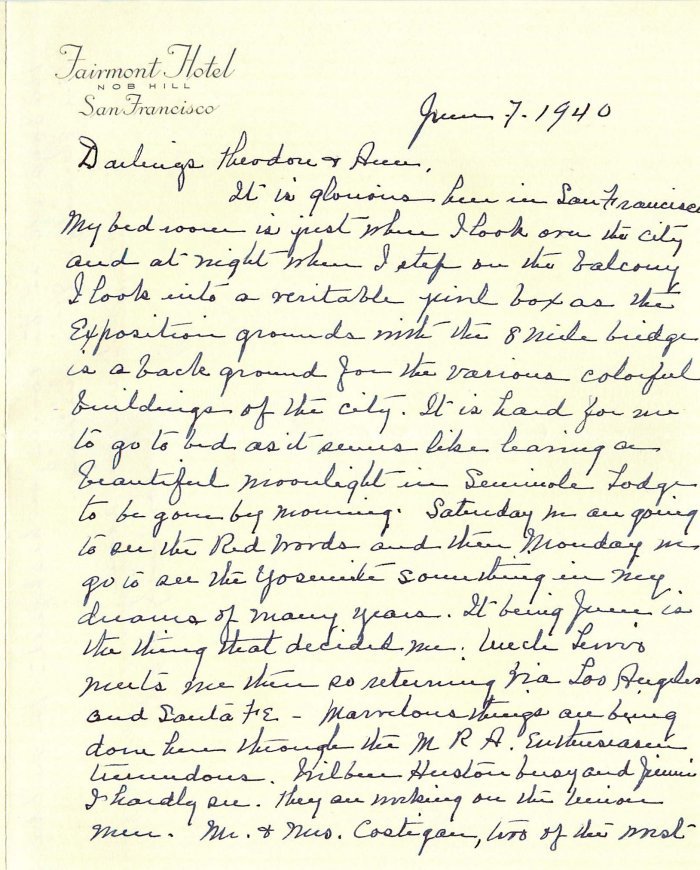 [X456HEC], Letter from Mina Miller (Mrs Thomas A.) Edison to Theodore Miller Edison, Ann Osterhout (Mrs Theodore M.) Edison, June 7th, 1940 1940-06-07
[X456HEC], Letter from Mina Miller (Mrs Thomas A.) Edison to Theodore Miller Edison, Ann Osterhout (Mrs Theodore M.) Edison, June 7th, 1940 1940-06-07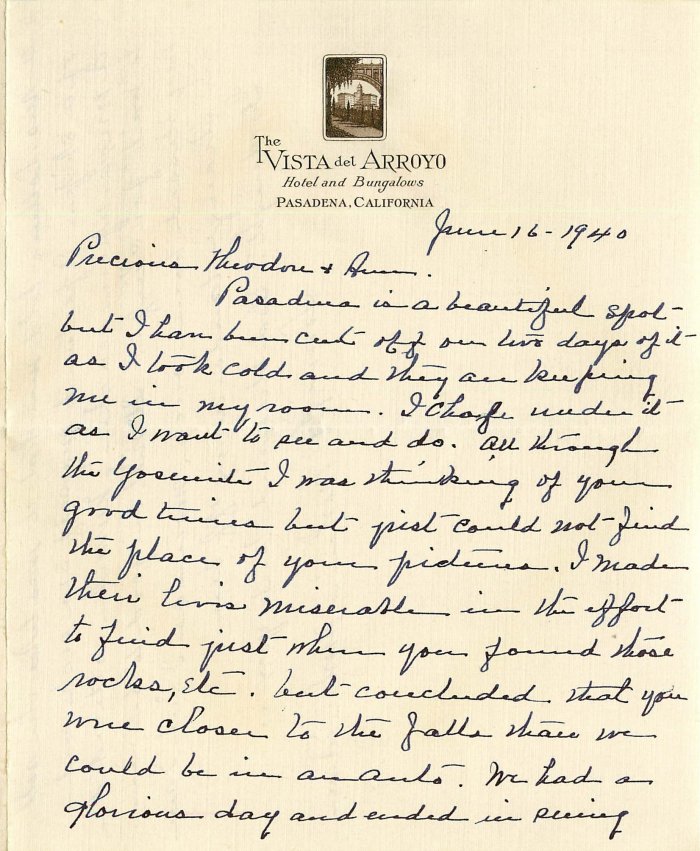 [X456HED], Letter from Mina Miller (Mrs Thomas A.) Edison to Theodore Miller Edison, Ann Osterhout (Mrs Theodore M.) Edison, June 16th, 1940 1940-06-16
[X456HED], Letter from Mina Miller (Mrs Thomas A.) Edison to Theodore Miller Edison, Ann Osterhout (Mrs Theodore M.) Edison, June 16th, 1940 1940-06-16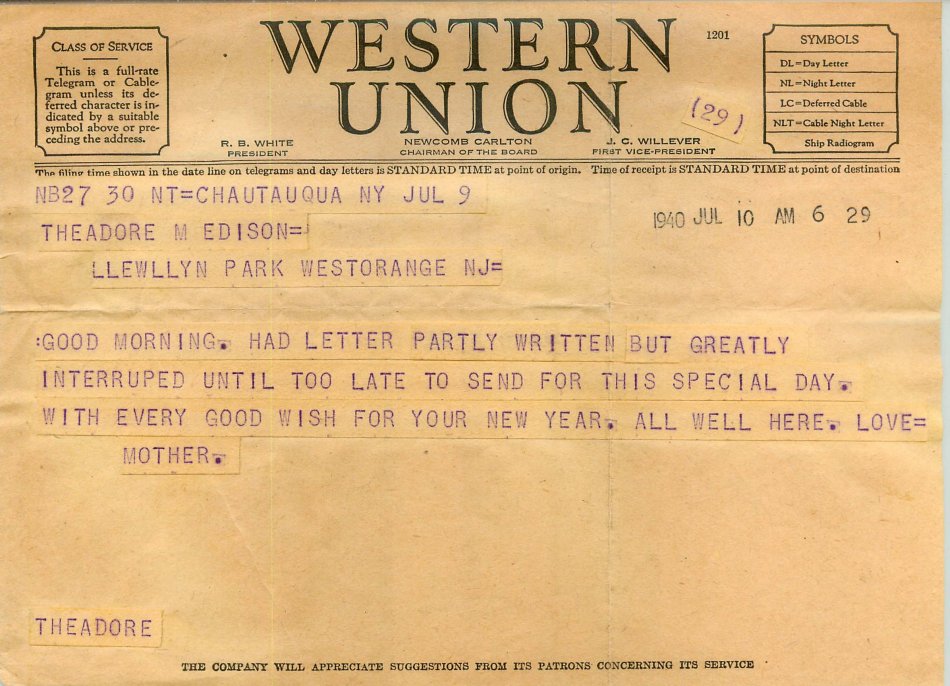 [X456HEE], Telegram from Mina Miller (Mrs Thomas A.) Edison to Theodore Miller Edison, July 9th, 1940 1940-07-09
[X456HEE], Telegram from Mina Miller (Mrs Thomas A.) Edison to Theodore Miller Edison, July 9th, 1940 1940-07-09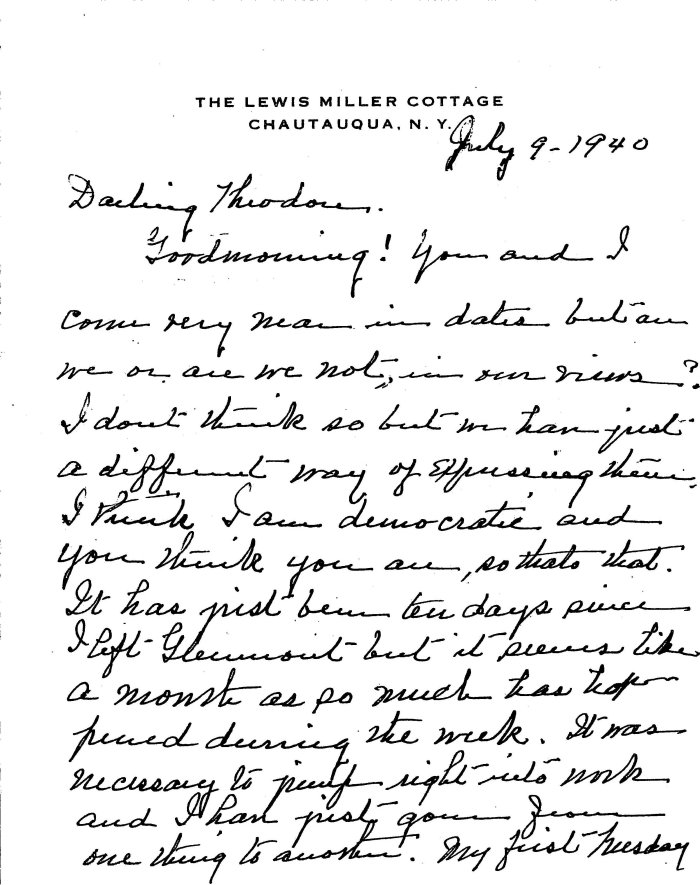 [X456HEF], Letter from Mina Miller (Mrs Thomas A.) Edison to Theodore Miller Edison, July 9th, 1940 1940-07-09
[X456HEF], Letter from Mina Miller (Mrs Thomas A.) Edison to Theodore Miller Edison, July 9th, 1940 1940-07-09 [X456HEG], Letter from Mina Miller (Mrs Thomas A.) Edison to Theodore Miller Edison, Ann Osterhout (Mrs Theodore M.) Edison, July 14th, 1940 1940-07-14
[X456HEG], Letter from Mina Miller (Mrs Thomas A.) Edison to Theodore Miller Edison, Ann Osterhout (Mrs Theodore M.) Edison, July 14th, 1940 1940-07-14 [X456HEH], Letter from Mina Miller (Mrs Thomas A.) Edison to Ann Osterhout (Mrs Theodore M.) Edison, Theodore Miller Edison, July 28th, 1940 1940-07-28
[X456HEH], Letter from Mina Miller (Mrs Thomas A.) Edison to Ann Osterhout (Mrs Theodore M.) Edison, Theodore Miller Edison, July 28th, 1940 1940-07-28 [X456HEI], Letter from Mina Miller (Mrs Thomas A.) Edison to Theodore Miller Edison, July 29th, 1940 1940-07-29
[X456HEI], Letter from Mina Miller (Mrs Thomas A.) Edison to Theodore Miller Edison, July 29th, 1940 1940-07-29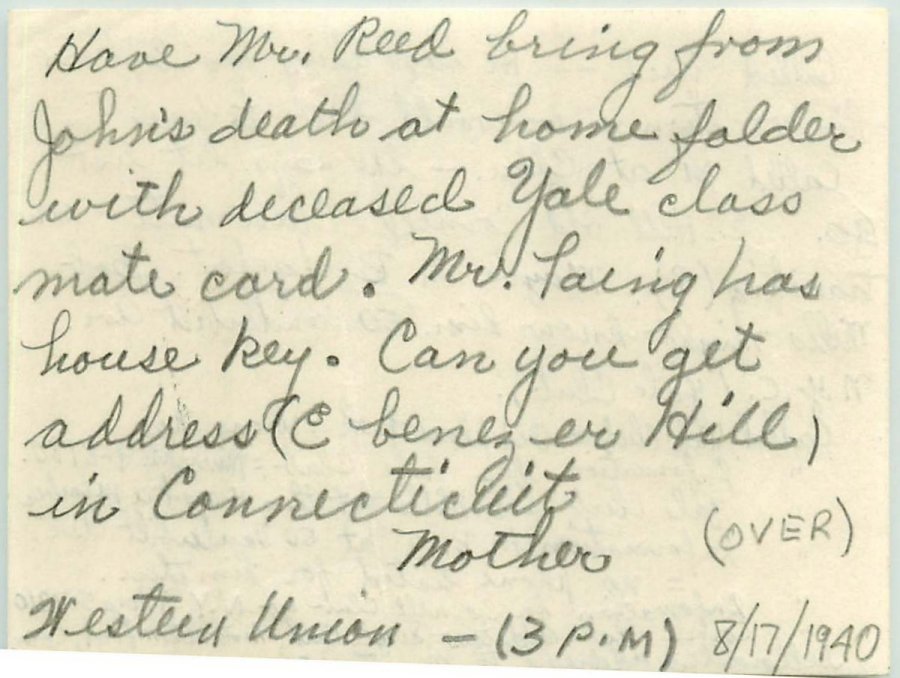 [X456HEI1], Telegram from Mina Miller (Mrs Thomas A.) Edison to Theodore Miller Edison, August 17th, 1940 1940-08-17
[X456HEI1], Telegram from Mina Miller (Mrs Thomas A.) Edison to Theodore Miller Edison, August 17th, 1940 1940-08-17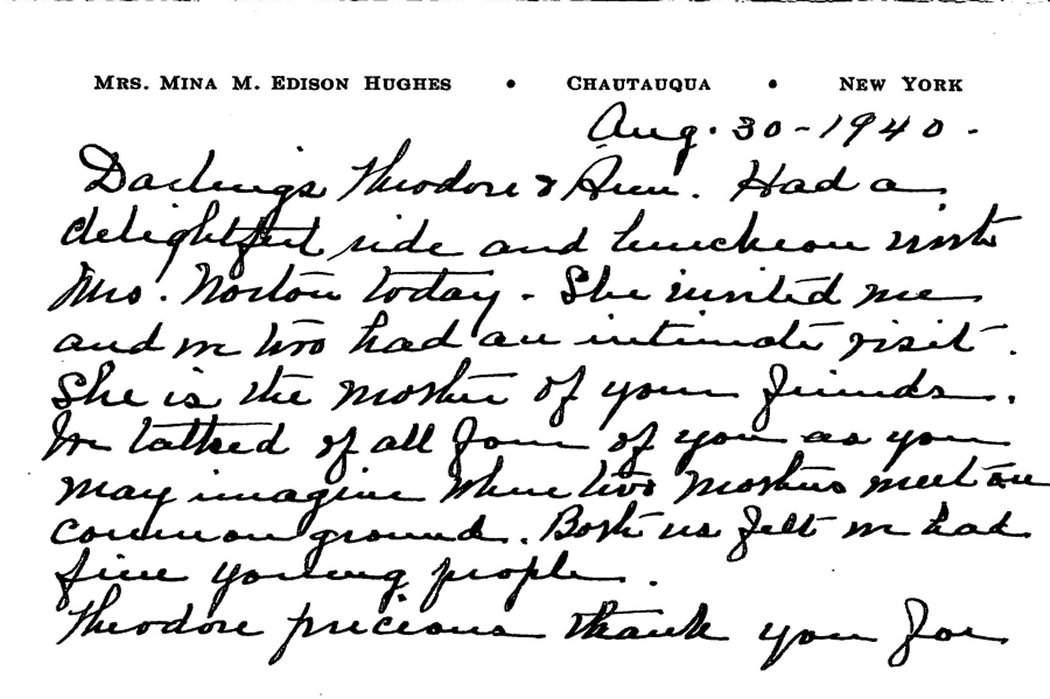 [X456HEJ], Letter from Mina Miller (Mrs Thomas A.) Edison to Theodore Miller Edison, Ann Osterhout (Mrs Theodore M.) Edison, August 30th, 1940 1940-08-30
[X456HEJ], Letter from Mina Miller (Mrs Thomas A.) Edison to Theodore Miller Edison, Ann Osterhout (Mrs Theodore M.) Edison, August 30th, 1940 1940-08-30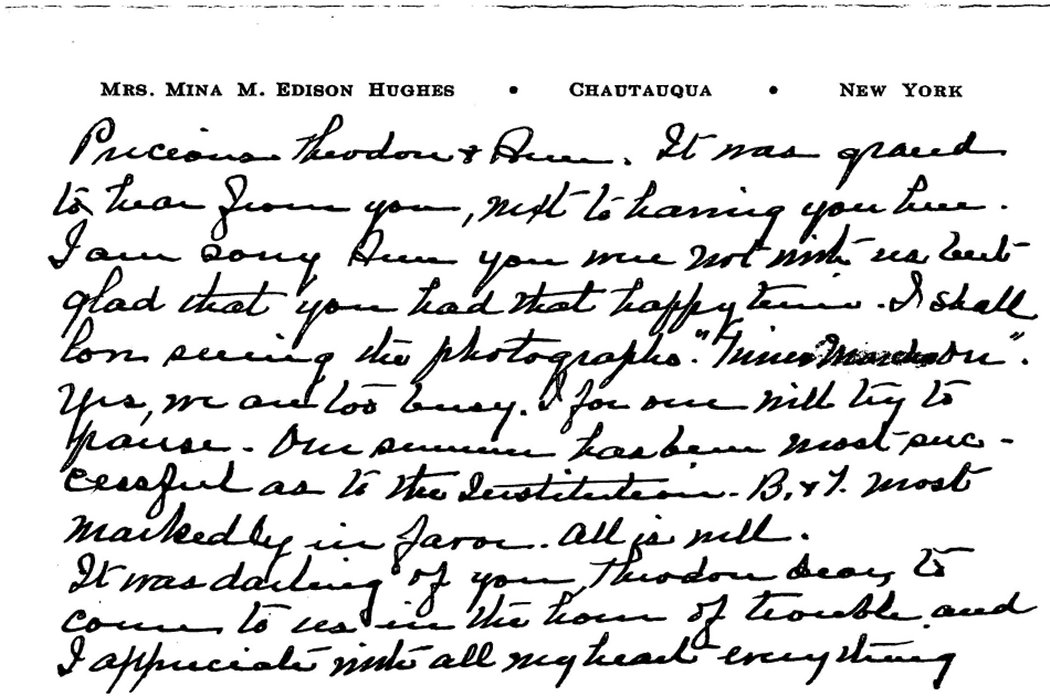 [X456HEK], Letter from Mina Miller (Mrs Thomas A.) Edison to Theodore Miller Edison, Ann Osterhout (Mrs Theodore M.) Edison, September 4th, 1940 1940-09-04
[X456HEK], Letter from Mina Miller (Mrs Thomas A.) Edison to Theodore Miller Edison, Ann Osterhout (Mrs Theodore M.) Edison, September 4th, 1940 1940-09-04 [X456HEL], Letter from Mina Miller (Mrs Thomas A.) Edison to Ann Osterhout (Mrs Theodore M.) Edison, Theodore Miller Edison, January 5th, 1941 1941-01-05
[X456HEL], Letter from Mina Miller (Mrs Thomas A.) Edison to Ann Osterhout (Mrs Theodore M.) Edison, Theodore Miller Edison, January 5th, 1941 1941-01-05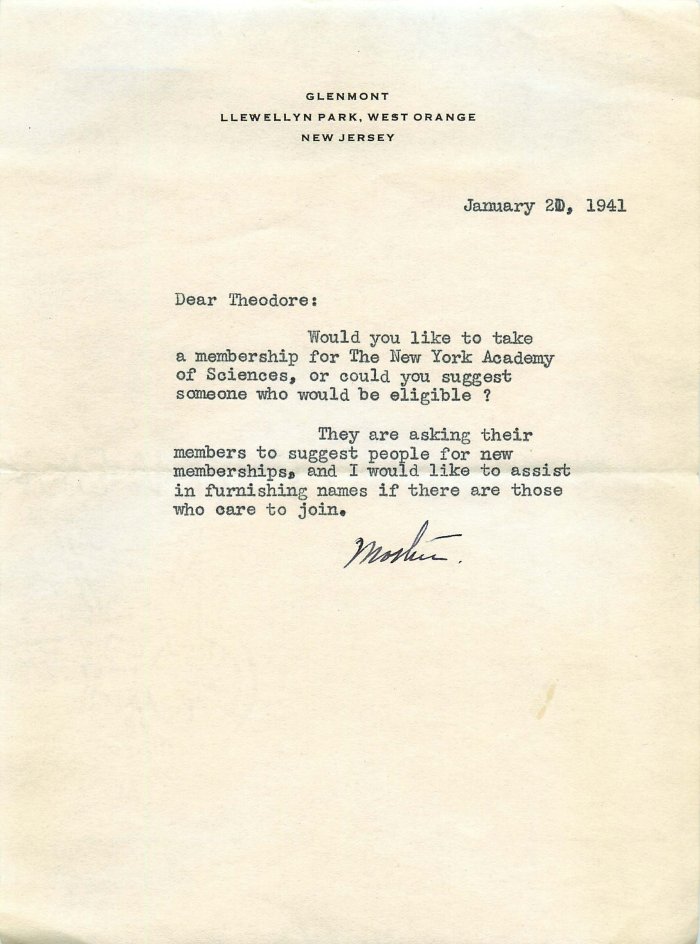 [X456HEM], Letter from Mina Miller (Mrs Thomas A.) Edison to Theodore Miller Edison, January 20th, 1941 1941-01-20
[X456HEM], Letter from Mina Miller (Mrs Thomas A.) Edison to Theodore Miller Edison, January 20th, 1941 1941-01-20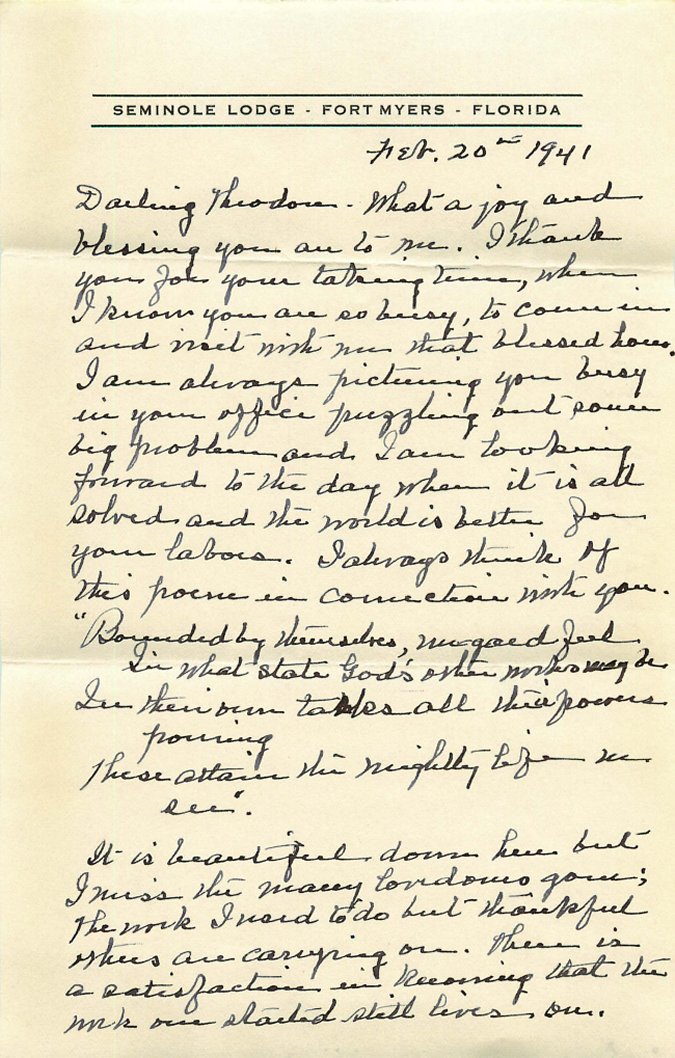 [X456HEN], Letter from Mina Miller (Mrs Thomas A.) Edison to Theodore Miller Edison, February 20th, 1941 1941-02-20
[X456HEN], Letter from Mina Miller (Mrs Thomas A.) Edison to Theodore Miller Edison, February 20th, 1941 1941-02-20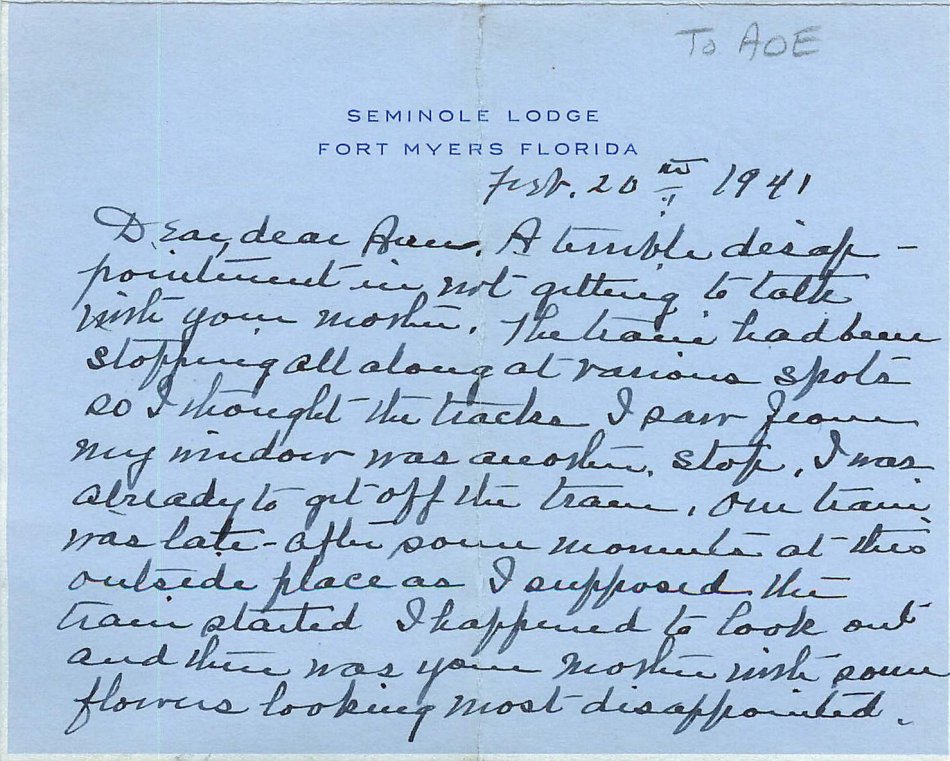 [X456HEO], Letter from Mina Miller (Mrs Thomas A.) Edison to Ann Osterhout (Mrs Theodore M.) Edison, February 20th, 1941 1941-02-20
[X456HEO], Letter from Mina Miller (Mrs Thomas A.) Edison to Ann Osterhout (Mrs Theodore M.) Edison, February 20th, 1941 1941-02-20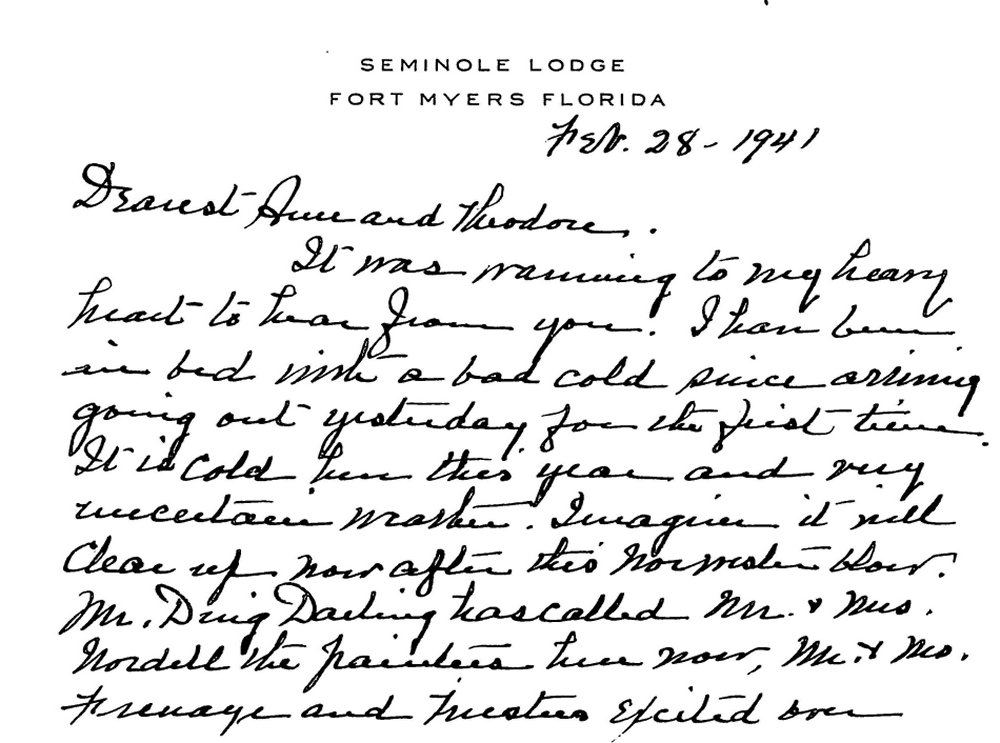 [X456HEP], Letter from Mina Miller (Mrs Thomas A.) Edison to Theodore Miller Edison, Ann Osterhout (Mrs Theodore M.) Edison, February 28th, 1941 1941-02-28
[X456HEP], Letter from Mina Miller (Mrs Thomas A.) Edison to Theodore Miller Edison, Ann Osterhout (Mrs Theodore M.) Edison, February 28th, 1941 1941-02-28 [X456HEQ], Letter from Mina Miller (Mrs Thomas A.) Edison to Theodore Miller Edison, March 13th, 1941 1941-03-13
[X456HEQ], Letter from Mina Miller (Mrs Thomas A.) Edison to Theodore Miller Edison, March 13th, 1941 1941-03-13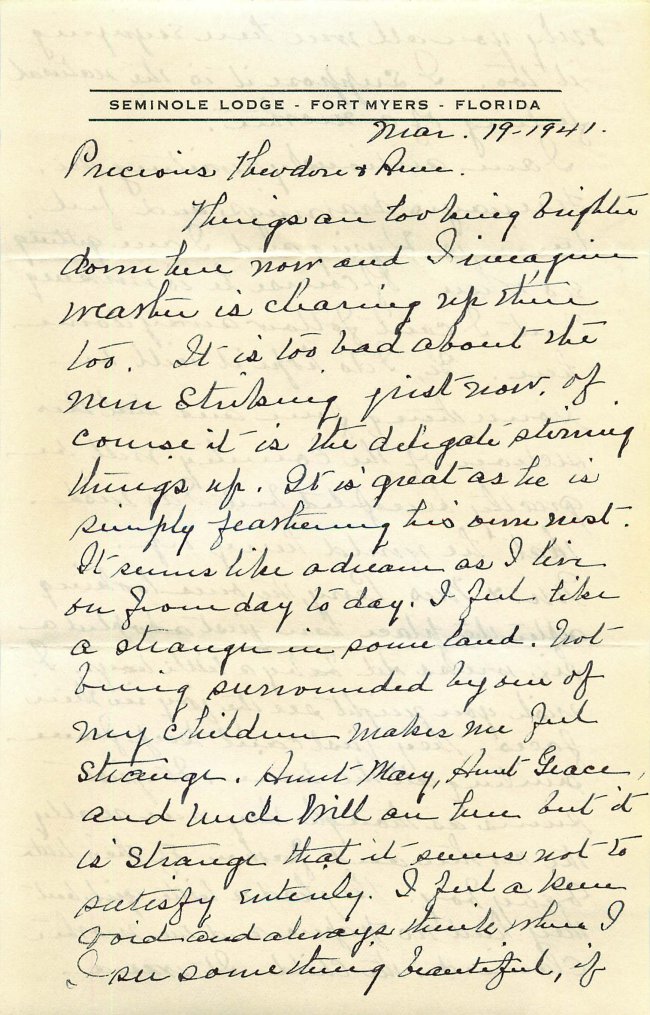 [X456HER], Letter from Mina Miller (Mrs Thomas A.) Edison to Theodore Miller Edison, Ann Osterhout (Mrs Theodore M.) Edison, March 19th, 1941 1941-03-19
[X456HER], Letter from Mina Miller (Mrs Thomas A.) Edison to Theodore Miller Edison, Ann Osterhout (Mrs Theodore M.) Edison, March 19th, 1941 1941-03-19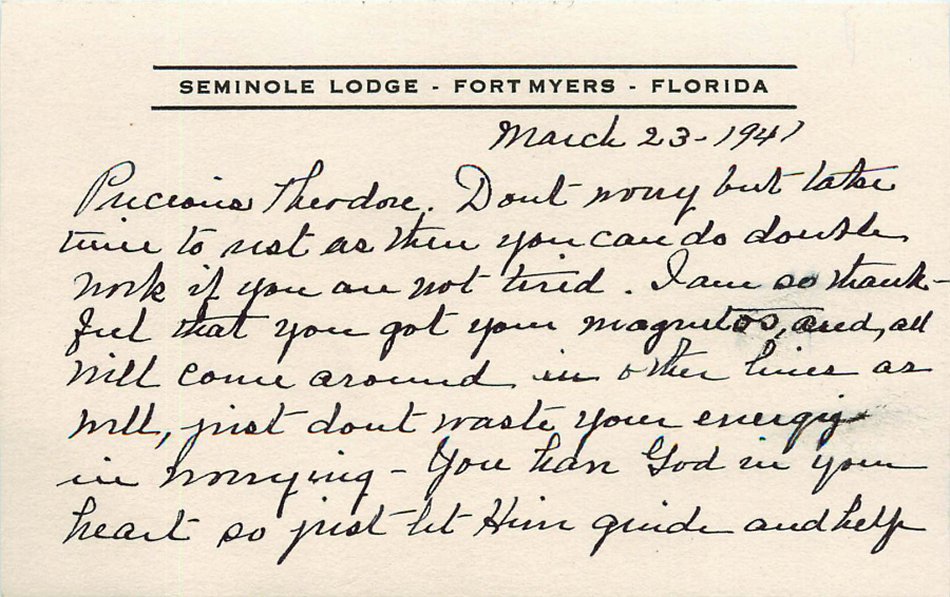 [X456HES], Letter from Mina Miller (Mrs Thomas A.) Edison to Theodore Miller Edison, March 23rd, 1941 1941-03-23
[X456HES], Letter from Mina Miller (Mrs Thomas A.) Edison to Theodore Miller Edison, March 23rd, 1941 1941-03-23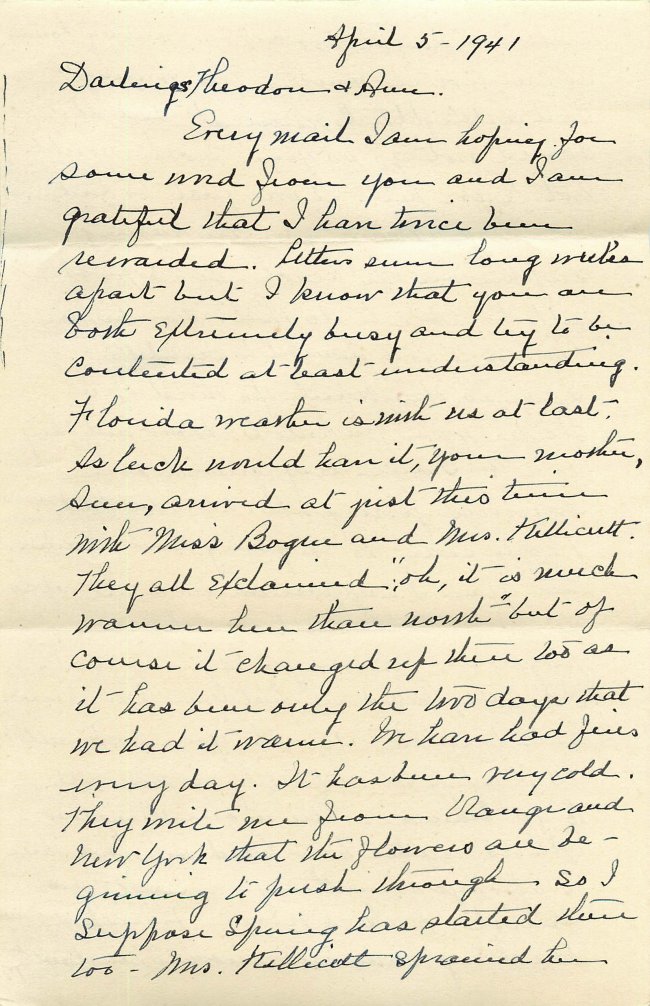 [X456HET], Letter from Mina Miller (Mrs Thomas A.) Edison to Theodore Miller Edison, Ann Osterhout (Mrs Theodore M.) Edison, April 5th, 1941 1941-04-05
[X456HET], Letter from Mina Miller (Mrs Thomas A.) Edison to Theodore Miller Edison, Ann Osterhout (Mrs Theodore M.) Edison, April 5th, 1941 1941-04-05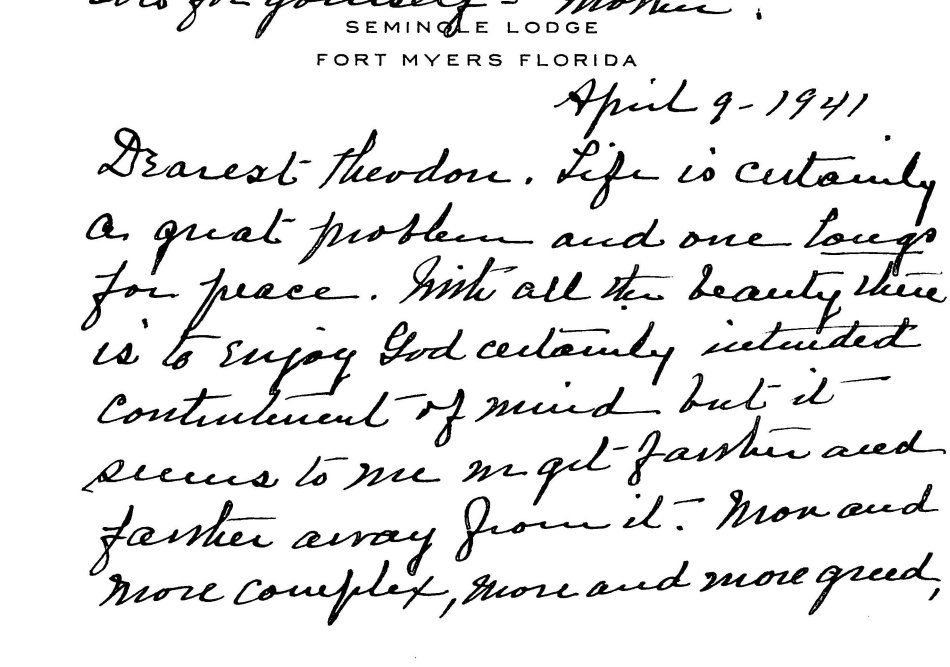 [X456HEU], Letter from Mina Miller (Mrs Thomas A.) Edison to Theodore Miller Edison, April 9th, 1941 1941-04-09
[X456HEU], Letter from Mina Miller (Mrs Thomas A.) Edison to Theodore Miller Edison, April 9th, 1941 1941-04-09 [X456HEV], Letter from Mina Miller (Mrs Thomas A.) Edison to Theodore Miller Edison, June 22nd, 1941 1941-06-22
[X456HEV], Letter from Mina Miller (Mrs Thomas A.) Edison to Theodore Miller Edison, June 22nd, 1941 1941-06-22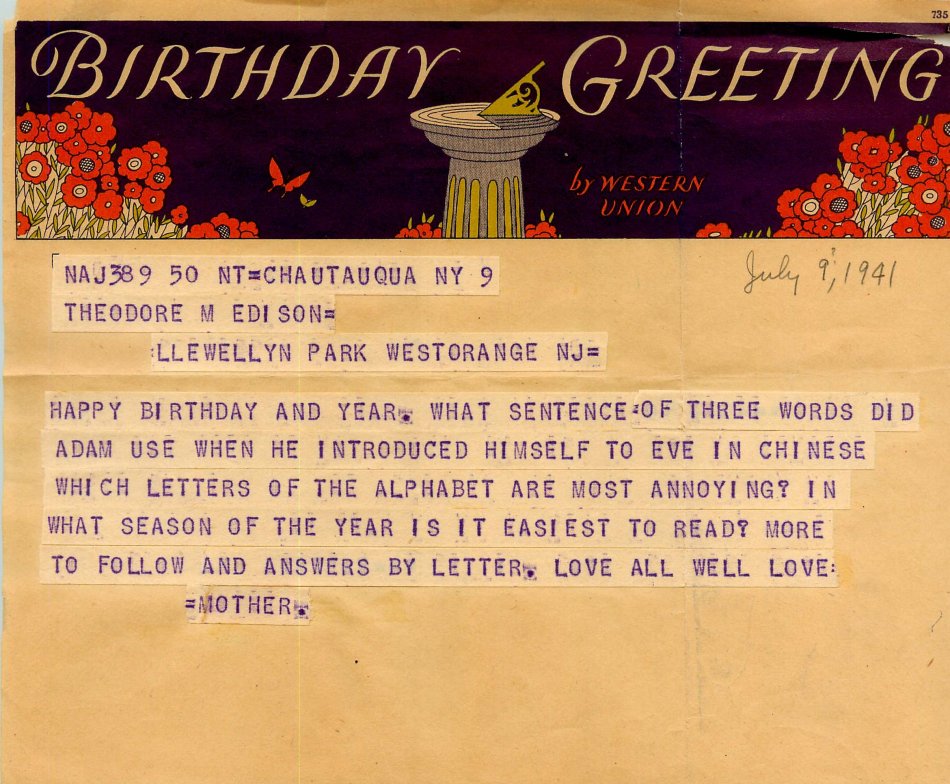 [X456HEW], Telegram from Mina Miller (Mrs Thomas A.) Edison to Theodore Miller Edison, July 9th, 1941 1941-07-09
[X456HEW], Telegram from Mina Miller (Mrs Thomas A.) Edison to Theodore Miller Edison, July 9th, 1941 1941-07-09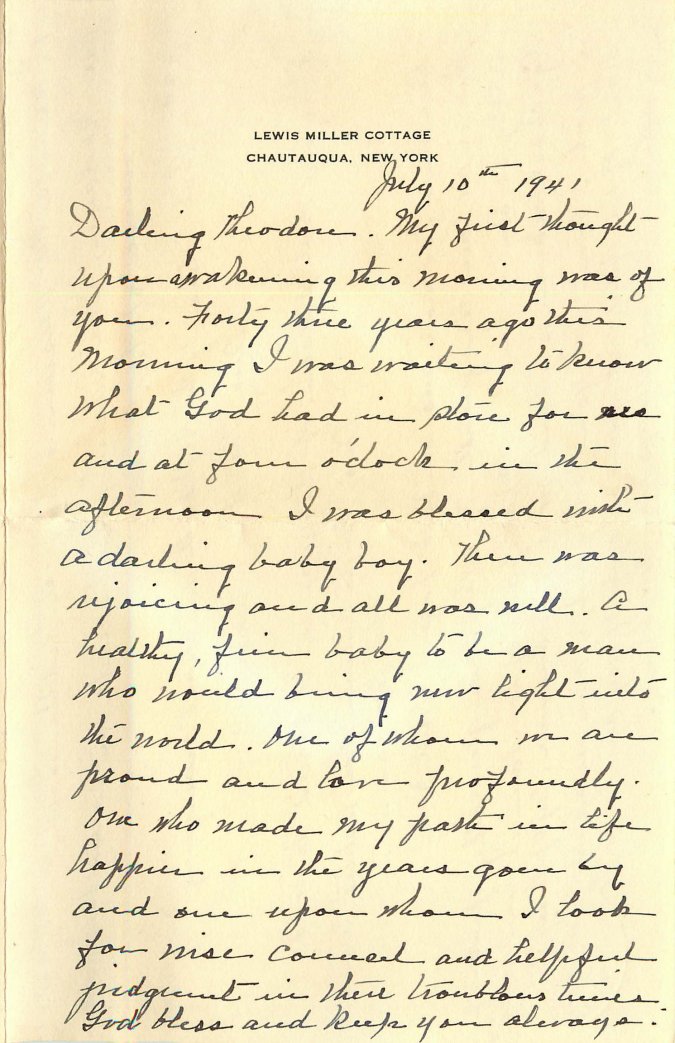 [X456HEX], Letter from Mina Miller (Mrs Thomas A.) Edison to Theodore Miller Edison, Ann Osterhout (Mrs Theodore M.) Edison, July 10th, 1941 1941-07-10
[X456HEX], Letter from Mina Miller (Mrs Thomas A.) Edison to Theodore Miller Edison, Ann Osterhout (Mrs Theodore M.) Edison, July 10th, 1941 1941-07-10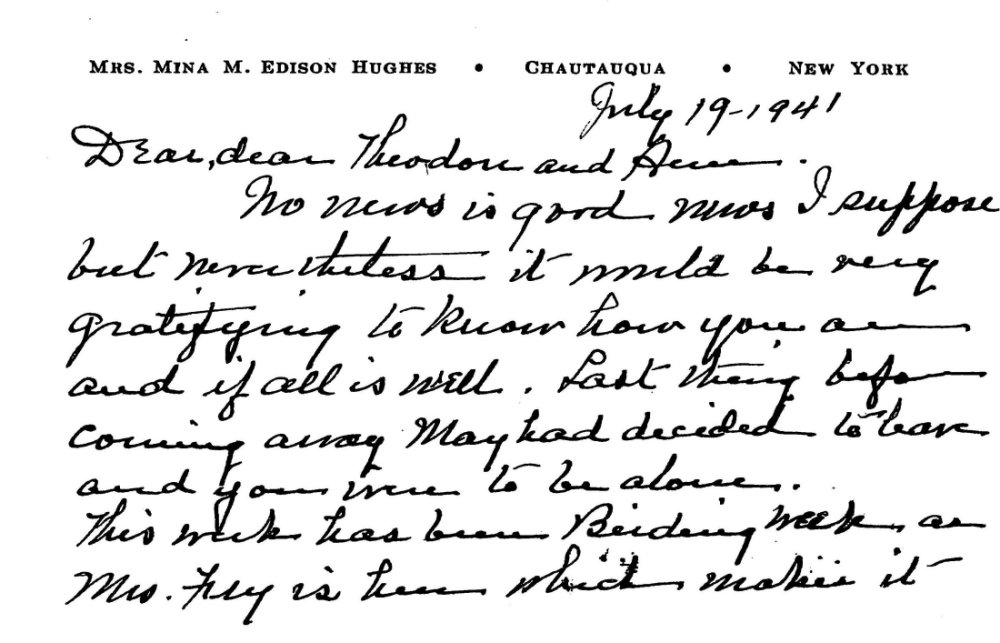 [X456HEY], Letter from Mina Miller (Mrs Thomas A.) Edison to Ann Osterhout (Mrs Theodore M.) Edison, Theodore Miller Edison, July 19th, 1941 1941-07-19
[X456HEY], Letter from Mina Miller (Mrs Thomas A.) Edison to Ann Osterhout (Mrs Theodore M.) Edison, Theodore Miller Edison, July 19th, 1941 1941-07-19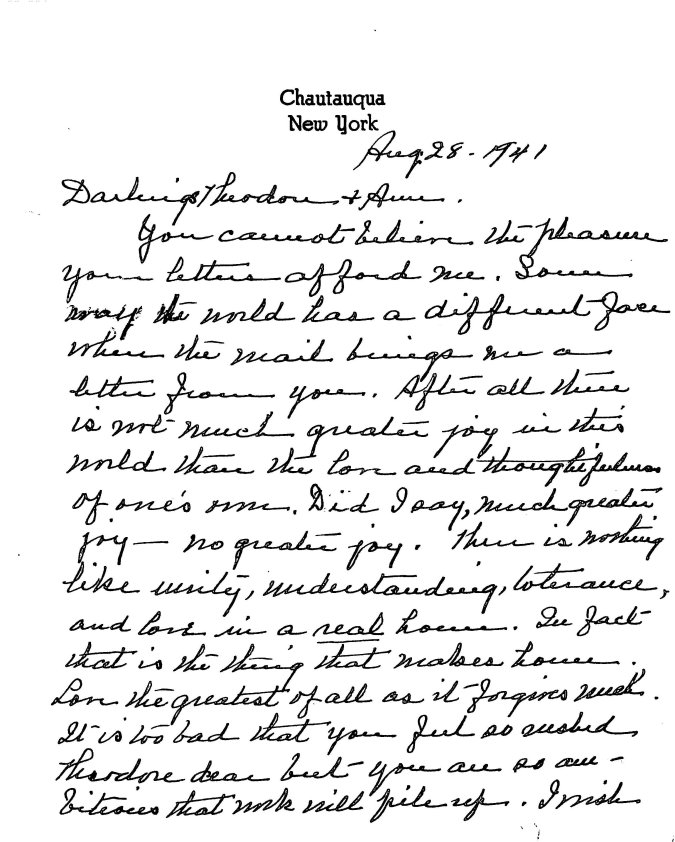 [X456HEZ], Letter from Mina Miller (Mrs Thomas A.) Edison to Theodore Miller Edison, Ann Osterhout (Mrs Theodore M.) Edison, August 28th, 1941 1941-08-28
[X456HEZ], Letter from Mina Miller (Mrs Thomas A.) Edison to Theodore Miller Edison, Ann Osterhout (Mrs Theodore M.) Edison, August 28th, 1941 1941-08-28